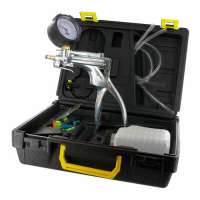SYKES PICKAVANT SONOSCOPE
The sonoscope is a highly sensitive device designed to detect abnormal sounds and vibrations in machinery and vehicles.
Equipped with an advanced diaphragm, this sound detector amplifies the smallest noises, making it easy to identify mechanical problems in their early stages.
The robust construction of the sonoscope, with a combination of high-quality metal and plastic, ensures durability and resistance in demanding work environments.
The 550mm hose allows adequate reach for inspecting hard-to-reach components, while the 290mm sonode is optimized to pick up a wide range of sound frequencies.
This device is an essential tool for diagnosing vehicle problems, such as faulty water pumps, bad wheel bearings, and alternator failures, among others.
Recommendations for use
Make sure the vehicle or machine is running during the inspection to pick up any noise abnormalities.
Keep the hose and probe away from moving parts to avoid damage to the device and possible injury.
Adjust the volume of the sonoscope according to the intensity of ambient noise for better detection clarity.
Use the sonoscope at different points on the machine or vehicle to precisely locate the source of the noise.
Please maintain a stable position when using the sonoscope to avoid false detections caused by user movement.
Maintenance recommendations
Regular Cleaning: Wipe the sonoscope with a soft, dry cloth to prevent the buildup of dust and debris that may affect its sensitivity.
Proper Storage: Store the sonoscope in a dry, protected location, away from direct exposure to sun or moisture, to prolong its life.
Periodic Check: Regularly inspect the diaphragm and hose connections to ensure there is no wear or damage that could affect the performance of the device.
Equipped with an advanced diaphragm, this sound detector amplifies the smallest noises, making it easy to identify mechanical problems in their early stages.
The robust construction of the sonoscope, with a combination of high-quality metal and plastic, ensures durability and resistance in demanding work environments.
The 550mm hose allows adequate reach for inspecting hard-to-reach components, while the 290mm sonode is optimized to pick up a wide range of sound frequencies.
This device is an essential tool for diagnosing vehicle problems, such as faulty water pumps, bad wheel bearings, and alternator failures, among others.
Recommendations for use
Make sure the vehicle or machine is running during the inspection to pick up any noise abnormalities.
Keep the hose and probe away from moving parts to avoid damage to the device and possible injury.
Adjust the volume of the sonoscope according to the intensity of ambient noise for better detection clarity.
Use the sonoscope at different points on the machine or vehicle to precisely locate the source of the noise.
Please maintain a stable position when using the sonoscope to avoid false detections caused by user movement.
Maintenance recommendations
Regular Cleaning: Wipe the sonoscope with a soft, dry cloth to prevent the buildup of dust and debris that may affect its sensitivity.
Proper Storage: Store the sonoscope in a dry, protected location, away from direct exposure to sun or moisture, to prolong its life.
Periodic Check: Regularly inspect the diaphragm and hose connections to ensure there is no wear or damage that could affect the performance of the device.
Bullet points
- High sound sensitivity: Its amplified diaphragm allows even the slightest noises to be detected, making it easier to identify faults before they become major problems.
- Durable Construction: The combination of robust metal and plastic ensures long product life, even under demanding working conditions.
- Early fault detection: By identifying mechanical problems in their initial phases, the user can make preventive repairs, avoiding costly major damage.
- Diagnostic Versatility: It is a useful tool for a wide range of applications, allowing the user to diagnose different vehicle components with a single device.
SYKES PICKAVANT SONOSCOPE reference list
| Ref. | Weight | Price | Purpose | Sparepart | Accessories | Buy |
|---|---|---|---|---|---|---|
| 323700 | 0.2Kg | 63,30 € | Ruidos |  |



























































































































































































